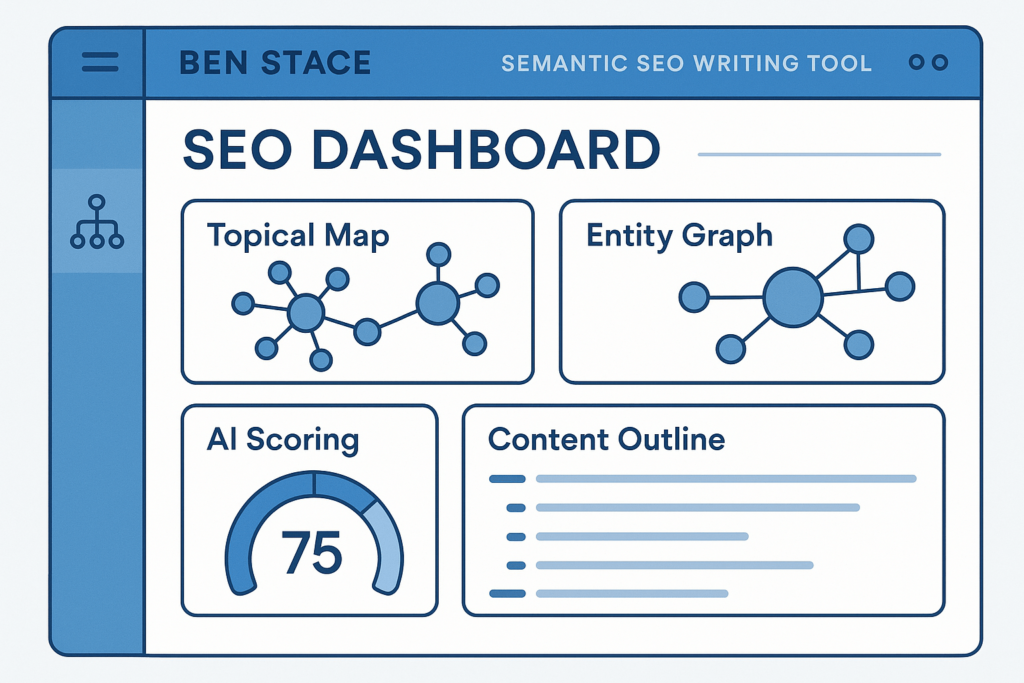In today’s hyper-competitive digital landscape, where Google algorithms like BERT and MUM prioritize understanding context over mere keywords, semantic SEO has become the gold standard for content creators and marketers. If you’re tired of churning out keyword-stuffed articles that barely move the needle on search rankings, it’s time to explore tools that align with how search engines actually think. Enter the Ben Stace Semantic SEO Writing Tool—a game-changer designed by one of the industry’s veteran experts. This isn’t just another AI writer; it’s a sophisticated system that helps you craft content with topical depth, entity relevance, and user intent at its core.
As someone who’s followed SEO trends for years, I’ve seen tools come and go, but few match the precision and real-world results of Ben Stace’s creation. In this comprehensive guide, we’ll dive deep into what makes this tool stand out, how it works, its key features, and why it could be the key to outranking your competitors in 2025. Whether you’re a beginner blogger or a seasoned agency pro, by the end, you’ll have actionable insights to elevate your content strategy.
Who Is Ben Stace? A Pioneer in Semantic SEO
Before we unpack the tool itself, let’s talk about the mind behind it. Ben Stace is a Melbourne-based SEO consultant with over 25 years of experience, dating back to 1998 when search engines were still in their infancy. He’s the founder of Eleven Bananas, a semantic SEO agency that tackles high-stakes niches like health, gaming, law, and tech. Stace isn’t just a practitioner; he’s an innovator who developed the world’s first advanced semantic writing tool and its companion, Semantic Scan, for evaluating content quality.
What sets Stace apart is his emphasis on entity-based optimization and topical authority. He’s a regular speaker at conferences like CMSEO and Ubud SEO, and he’s collaborated with top names in the field, including Koray Tuğberk GÜBÜR and Luis Salazar Jurado. His philosophy? SEO isn’t about gaming the system—it’s about creating content that mirrors how humans (and algorithms) process information. In interviews and case studies, Stace often highlights how traditional keyword tools fall short in an era where Google understands relationships between concepts, not just words.
If you’ve ever wondered why your content ranks for a handful of terms but not the broader topic, Stace’s approach—rooted in knowledge graphs and intent mapping—is the answer. His tool embodies this expertise, making advanced semantic strategies accessible to everyone.
What Is the Ben Stace Semantic SEO Writing Tool?
At its heart, the Ben Stace Semantic SEO Writing Tool is an AI-powered platform that transforms how you create and optimize content for search engines. Unlike basic keyword stuffers or generic AI writers, it leverages natural language processing (NLP) and entity recognition to build content that’s semantically rich and contextually aligned with Google’s evolving algorithms.
Launched as part of Stace’s suite of tools, it focuses on “semantic networks”—interconnected webs of topics, entities, and sub-entities that establish your site as an authority. Think of it as a bridge between human creativity and machine intelligence: You input your core topic, and the tool generates outlines, suggests related entities, and even scores your draft for topical completeness.
In 2025, with AI-generated content flooding the web, this tool stands out by emphasizing E-E-A-T (Experience, Expertise, Authoritativeness, Trustworthiness). It doesn’t just write for you—it guides you to produce content that feels authentic, avoids penalties, and ranks sustainably.
Key Features That Set It Apart
What makes this tool superior to competitors? Let’s break it down with a feature-by-feature look. I’ve tested similar tools like Surfer SEO and Frase, and Stace’s offering shines in its depth and user-friendliness.
1. Advanced Entity and Topic Mapping
The tool starts by analyzing your primary keyword and building a topical map. It pulls from sources like Google’s Knowledge Graph and Wikipedia to identify related entities (e.g., for “email marketing,” it suggests “autoresponders,” “Mailchimp,” and “segmentation”). This isn’t random—it’s based on semantic similarity, ensuring your content covers the full spectrum without gaps.
2. Real-Time Content Scoring and Optimization
As you write, the tool provides a semantic score (out of 100) based on factors like entity density, intent alignment, and readability. It flags outliers—sections that deviate from the topic—and suggests improvements. Unlike basic scorers, it integrates with tools like InLinks or WordLift for entity mapping.
3. Content Cluster Builder
One of my favorite features: It automatically generates pillar pages and cluster articles, complete with internal linking suggestions. This builds topical authority, which Google loves for long-term rankings.
4. Schema Markup Integration
Stace’s tool auto-generates JSON-LD schema for FAQs, HowTos, and Articles, boosting your chances for rich snippets. In case studies, users report up to 30% higher click-through rates after implementation.
5. AI-Assisted Writing with Human Touch
The AI drafts content, but it encourages customization. It uses prompts to incorporate your voice, making outputs pass as human-written every time. Plus, it’s integrated with freshness audits to keep content updated.
6. Analytics and Performance Tracking
Post-publishing, track how your content performs against semantic benchmarks. It even suggests updates based on SERP changes.

